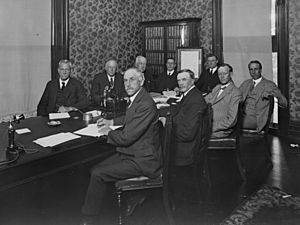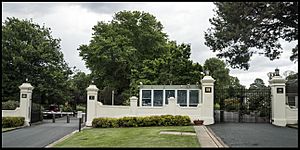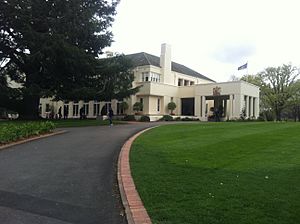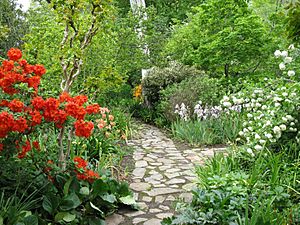Government House, Canberra facts for kids
Quick facts for kids Government House |
|
|---|---|

Government House, viewed garden side
|
|
| Alternative names | Yarralumla |
| General information | |
| Status | Complete |
| Type | Official residence |
| Architectural style |
|
| Location | Yarralumla, Australian Capital Territory |
| Country | Australia |
| Coordinates | 35°18′06″S 149°04′40″E / 35.301612°S 149.077670°E |
| Current tenants | Governor-General of Australia, presently General David Hurley AC, DSC, FTSE |
| Construction started | 1859 |
| Renovated | 1927; 1939; 1990s |
| Client | Frederick Campbell (grazier) |
| Owner | Commonwealth of Australia |
| Grounds | 54 hectares (130 acres) |
| Design and construction | |
| Other designers |
|
| Renovating team | |
| Architect |
|
| Official name: Yarralumla and Surrounds, Dunrossil Dr, Yarralumla, ACT, Australia | |
| Type: | Listed place |
| Criteria: | A., B., E., F., G., H. |
| Designated: | 22 June 2004 |
| Reference #: | 105381 |
Government House, also known as Yarralumla, is the official home of the Governor-General of Australia. The Governor-General is the King's representative in Australia. This important building is located in Yarralumla, a suburb of Canberra, Australia's capital city.
The house sits within a large park that is about 54 hectares (133 acres) in size. In 2004, Government House and its grounds were added to the Commonwealth Heritage List. This means they are protected for their historical and cultural importance.
At Government House, the Governor-General does many important jobs. They lead meetings of the Federal Executive Council, which helps the government make decisions. They also give out awards like those from the Order of Australia to people who have done great things for the country.
Important visitors, like leaders from other countries and ambassadors, are welcomed here. The Governor-General also hosts many events for people from all parts of Australian life. When the Queen of Australia (or King) visits Canberra, they stay at Government House. Other foreign leaders also stay here during their official visits.
Contents
History of Government House
How Yarralumla Became Government House
When Walter Burley Griffin designed Canberra, he planned a special, grand house for the Governor-General. This house was meant to have amazing views of the city's parks and lake. However, due to money issues, this grand plan was never built.
Instead, the current Government House started as a smaller home. It was built in 1891 by a sheep farmer named Frederick Campbell. At that time, it was the main house on a working sheep farm called Yarralumla. Before this, an older, elegant house stood on the same spot from 1837 to 1881.
Early Owners and Changes
European explorers arrived in the Canberra area in the 1820s. Farmers soon followed, bringing their animals to graze. The land where Yarralumla stands was first granted to Henry Donnison in 1828. It was then sold a few times before being bought by Terence Aubrey Murray and Thomas Walker in 1837.
Murray later owned the property alone and made it much larger. He was an important politician in New South Wales. Around 1840, Murray planted a special type of cedar tree, the Deodar Cedar, at Yarralumla. He also added many decorative plants around the native trees.
In 1859, Augustus Onslow Manby "Gussie" Gibbes bought Yarralumla from his brother-in-law, Terence Murray. Gussie Gibbes improved the property. Besides sheep, he also raised horses to sell in India.
In 1881, Gussie Gibbes sold Yarralumla to Frederick Campbell for £40,000. Campbell was married and had a growing family. He needed a bigger home.
Building the Current House
In 1890, Frederick Campbell partly pulled down the old Yarralumla house. The next year, 1891, he finished building a new, three-story, red-brick house on the site. In 1899, Campbell removed the rest of the original house. He then added a large brick extension to the main building. He also built a big wooden shed for shearing sheep. This shed is still near the Molonglo River today.
Government House in the 20th Century
In 1913, the Australian Government bought Yarralumla from Frederick Campbell. They decided to use Campbell's house as a temporary home for the Governor-General. Another three-story section was added behind the existing house. A new main entrance was also built.
Since the 1920s, the building has been made bigger and updated many times. However, you can still see the original shape of the 1891 house from the south side.
First Governors-General at Yarralumla
Lord Stonehaven was the first Governor-General to live in the house. He moved in when the new Parliament House opened in Canberra in 1927. Sir Isaac Isaacs, who was Australian-born, was the first Governor-General to live at Government House for his entire term.
The house was still quite small compared to the Governor-General's previous home in Melbourne. Many Governors-General and their wives felt it wasn't big enough for official events. Plans for a much grander, permanent home were stopped because of the Great Depression in the 1930s. World War II also prevented further building work.
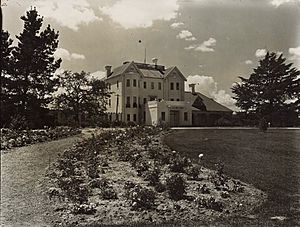
Australia's government moved from Melbourne to Canberra in 1927. This is when the Governor-General started using Yarralumla as his official home. However, at first, he only stayed there when the Parliament of Australia was meeting.
Interestingly, the Federal Cabinet (the group of top government ministers) met at Yarralumla House on January 30, 1924. This was three years before Parliament House opened and Canberra became the capital. In 1930, the Melbourne Government House was given back to the Victorian State Government.
Royal Visits and Renovations
In 1927, the Duke and Duchess of York (who later became King George VI and Queen Elizabeth) stayed at Government House. They were visiting Canberra to open the Provisional Parliament House. Before their arrival, the house was greatly improved to make sure it was suitable for the Royal Family. These changes were managed by John Smith Murdoch.
The inside of the house, including much of the furniture, was designed by Ruth Lane Poole. The design style was called "Inter-war Stripped Classical." The official rooms were more formal, while the private rooms were lighter and brighter.
In 1933, a private sitting room was added. This room has lovely views of the Brindabella Ranges.
In 1939, Government House was renovated and expanded again. Lord Gowrie was the Governor-General at the time. The 1899 extension was removed, and a larger, new section was built. The drawing room was made bigger, and more bedrooms were added. A "state entrance" was also built on the northern side.
These changes were planned because the Duke of Kent was expected to become the next Governor-General in 1945. However, he sadly died in a plane crash in 1942. His older brother, the Duke of Gloucester, took his place. The renovations were finished in time for the Duke and Duchess of Gloucester to arrive.
In the 1990s, a new office building was constructed. This building houses the offices for the Official Secretary and other staff.
Some people believe that the current Government House could be more impressive. Ideas for building a new Government House have been suggested over time, but none are being actively considered right now.
The Grounds of Government House
Government House is located in the southwestern part of Canberra, in the suburb of Yarralumla. It sits on the edge of Lake Burley Griffin. You reach it by driving along Dunrossil Drive, named after Lord Dunrossil, a Governor-General who passed away while in office.
At the entrance to the grounds, there are iron gates decorated with royal symbols. A small house for the gatekeeper is also there. The winding driveway leads to the house through beautiful lawns and gardens.
Before Canberra became the capital in 1927, the Australian Parliament met in Melbourne. Most government offices were also in Melbourne. The Governor-General lived in Government House, Melbourne. When Canberra was chosen as the future capital, the government bought Yarralumla Station. This large farming property from the 1830s included the brick house that would become Government House. The house was then renovated and made bigger to become the official residence.
Inside the Residence
Government House is made of a central brick section built by Frederick Campbell in 1890-1891. This was built on the remains of an older house from the 1830s. The house was made larger in 1899, and again in the 1920s, 1930s, and 1940s. All these parts are covered in a cream-colored cement layer, and the roof tiles are green.
The main entrance to Government House is on its eastern side. It has a covered area called a porte-cochère, where cars can pull up. Steps lead from here to the main doors.
Inside, the "State Entrance Hall" runs through the middle of the house. It has wood panels and is decorated with Australian artworks and furniture. These include a study by Sir William Dargie for his famous "Wattle Portrait" of Queen Elizabeth II.
Important events, like swearing in new government ministers or giving out awards, happen in the drawing room. This room has paintings by Australian artists and old Australian furniture.
The drawing room leads to the private entrance, which has several rooms. These rooms look out over the gardens towards the Brindabella Ranges. They also display Australian paintings and antique items.
Beyond the private entrance are a morning room and a smaller dining room. This dining room features a collection of paintings by Indigenous Australian artists.
On the side of the house facing the lake is the "State Dining Room." It has a large bay window with views of Lake Burley Griffin and leads out to a terrace. Also on the ground floor are the Governor-General's study, where they work and meet visitors, and a sitting room connected to offices.

The upper floors of Government House are where the Governor-General lives privately. There are also guest rooms for visitors.
The furniture and decorations in Government House show off many Australian artists and craftspeople. They represent different styles from colonial times to today. The house also has a large collection of art by Indigenous Australian artists. Many of the furniture pieces and artworks are on loan from important cultural places like the National Gallery of Australia and the National Library of Australia.
Some of the famous artists whose works are displayed include E. Phillips Fox, Tom Roberts, Sir Arthur Streeton, Sir William Dargie, Margaret Preston, Rupert Bunny, Sir Hans Heysen, Lloyd Rees, Fred Williams, Arthur Boyd, Sir Sidney Nolan, and many more.
The Beautiful Gardens
The house is surrounded by large, beautifully designed gardens. These gardens were first planned by a plant expert named Charles Weston. Many trees in the gardens have been planted by important visitors from around the world. The grounds have many trees and wide lawns. These lawns offer views of Black Mountain to the north and the Brindabella Ranges to the south.
The "Wild Garden" or "English Garden" was designed by Lady Gowrie. It includes a memorial to her son, Patrick Hore-Ruthven, who died in World War II. Other gardens have been created by different Governors-General and their partners over the years. For example, the lakeside lawn and terraces were developed in the 1960s when Lake Burley Griffin was filled with water.
In the 1970s, a garden with rhododendron flowers was designed and planted. It is called the "Hasluck Garden" after Governor-General Sir Paul and Dame Alexandra Hasluck. In the 1990s, many flower bulbs were planted along the eastern side of the "Vista Lawn."
A "Garden of Bravery" was also created at Government House. This garden honors different Australian civilian and military awards, like the Victoria Cross.
About 100 meters south of the house, there's a small dip in the "Vista Lawn." This spot marks where a brick vault once held the bodies of two early residents of the property, Elizabeth and Colonel John George Nathaniel Gibbes. In 1880, their coffins were moved and reburied at St John the Baptist Church in Reid. In the same churchyard, you can find the grave of Lord Dunrossil, who was Australia's 14th Governor-General and passed away while living at Yarralumla.
The current head gardener is Norman John Dunn.
Images for kids
See also
 In Spanish: Casa de Gobierno (Canberra) para niños
In Spanish: Casa de Gobierno (Canberra) para niños


